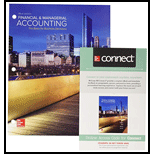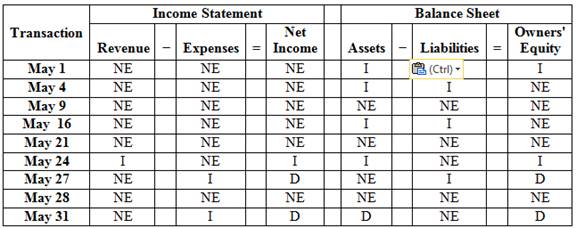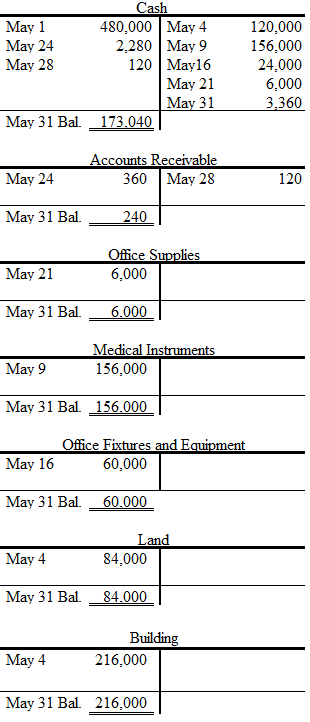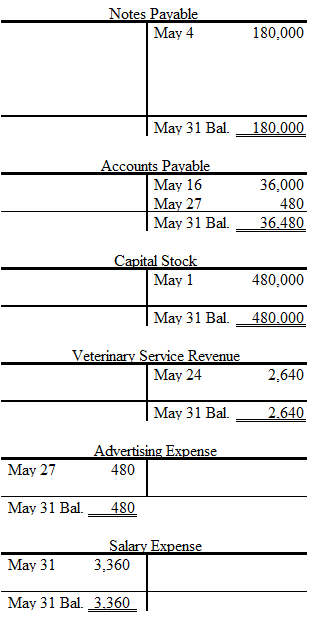
Concept explainers
a.
Analyze the effects that each of the given transactions will have on the following six components of the company’s financial statements for the month of May.
a.
Explanation of Solution
Income statement:
The financial statement which reports revenues and expenses from business operations and the result of those operations as net income or net loss for a particular time period is referred to as income statement.
This financial statement reports a company’s resources (assets) and claims of creditors (liabilities) and stockholders (stockholders’ equity) over those resources. The resources of the company are assets which include money contributed by stockholders and creditors. Hence, the main elements of the balance sheet are assets, liabilities, and
Analyze the effects that each of the given transactions will have on the following six components of the company’s financial statements for the month of May as follows:

Figure (1)
b.
Prepare journal entries for each transaction.
b.
Explanation of Solution
Journal entry is a set of economic events which can be measured in monetary terms. These are recorded chronologically and systematically.
Prepare journal entries for each transaction as follows:
| Date | Account title and Explanation | Post ref. |
Debit (in $) | Credit (in $) |
| May 1 | Cash | 480,000 | ||
| Capital stock | 480,000 | |||
| (To record the issue of the 6,000 shares of capital stock) | ||||
| May 4 | Land | 84,000 | ||
| Office Building | 216,000 | |||
| Cash | 120,000 | |||
| Notes Payable | 180,000 | |||
| (To record the purchase of land and office building) | ||||
| May 9 | Medical instruments | 156,000 | ||
| Cash | 156,000 | |||
| (To record the purchase of computer systems) | ||||
| May 16 | Office fixtures and equipment | 60,000 | ||
| Cash | 24,000 | |||
| Accounts Payable | 36,000 | |||
| (To record the purchase of office fixtures and equipment) | ||||
| May 21 | Office supplies | 6,000 | ||
| Cash | 6,000 | |||
| (To record the purchase of office supplies purchased on account) | ||||
| May 24 | Cash | 2,280 | ||
| Accounts receivable | 360 | |||
| Veterinary service revenue | 2,640 | |||
| (To record the veterinary service revenue earned) | ||||
| May 27 | Advertising expense | 480 | ||
| Accounts payable | 480 | |||
| (To record the advertising expense incurred) | ||||
| May 28 | Cash | 120 | ||
| Accounts receivable | 120 | |||
| (To record the cash collected from accounts receivable) | ||||
| May 31 | Salary expense | 3,360 | ||
| Cash | 3,360 | |||
| (To record the salary expense paid) |
Table (1)
c.
Post each transaction to the appropriate ledger accounts.
c.
Explanation of Solution
T-account:
The condensed form of a ledger is referred to as T-account. The left-hand side of this account is known as debit, and the right hand side is known as credit.
Post each transaction to the appropriate ledger accounts as follows:

Figure (2)

Figure (3)
d.
Prepare a
d.
Explanation of Solution
Trial balance:
Trial balance is a summary of all the ledger accounts balances presented in a tabular form with two column, debit and credit. It checks the mathematical accuracy of the
Prepare a trial balance dated May 31, current year as follows:
| Veterinary Clinic | ||
| Trial Balance | ||
| May 31, Current Year | ||
| Cash | $173,040 | |
| Accounts receivable | 240 | |
| Office supplies | 6,000 | |
| Medical instruments | 156,000 | |
| Office fixtures and equipment | 60,000 | |
| Land | 84,000 | |
| Building | 216,000 | |
| Notes payable | $180,000 | |
| Accounts payable | 36,480 | |
| Capital stock | 480,000 | |
| | 0 | |
| Veterinary service revenue | 2,640 | |
| Advertising expense | 480 | |
| Salary expense | 3,360 | |
| $699,120 | $699,120 | |
Table (2)
e.
Compute total assets, total liabilities, and owners’ equity and identify whether the month May appeared to be a profitable month.
e.
Explanation of Solution
Assets:
These are the resources owned and controlled by business and used to produce benefits for the company. Assets are classified on the balance sheet as current assets, non-current assets, property, plant, and equipment, and intangible assets.
Liabilities:
The claims creditors have over assets or resources of a company are referred to as liabilities. These are the debt obligations owed by company to creditors. Liabilities are classified on the balance sheet as current liabilities and long-term liabilities.
Owners’ equity:
Owner’s equity refers to the right the owner possesses over the resources of the business. Revenues and the expenses are the components of the owner’s equity.
Net income:
The bottom line of income statement which is the result of excess of earnings from operations (revenues) over the costs incurred for earning revenues (expenses) is referred to as net income.
Compute total assets, total liabilities, and owners’ equity as follows:
| Total Assets: | ||
| Cash | $173,040 | |
| Accounts receivable | 240 | |
| Office supplies | 6,000 | |
| Medical instruments | 156,000 | |
| Office fixtures and equipment | 60,000 | |
| Land | 84,000 | |
| Building | 216,000 | |
| Total assets | $695,280 | |
| Total Liabilities: | ||
| Notes payable | $180,000 | |
| Accounts payable | 36,480 | |
| Total liabilities | $216,480 | |
| Total Owners' Equity: | ||
| Total assets − Total liabilities | $478,800 |
Table (3)
Identify whether the month May appeared to be a profitable month as follows:
| Amount (In $) | Amount (In $) | |
| Veterinary service revenue | 2,640 | |
| Less: Advertising expense | 480 | |
| Salary expense | 3,360 | 3,840 |
| Net Loss | $ (1,200) |
Table (4)
Hence, the month May did not appear to be a profitable month.
Want to see more full solutions like this?
Chapter 3 Solutions
Gen Combo Looseleaf Financial And Managerial Accounting; Connect Access Card
- Henderson Corporation uses the calendar year as its tax year. It acquires and places into service two depreciable assets during 2024: • Asset #1: 7-year property; $940,000 cost; placed into service on January 20. Asset #2: 5-year property; $410,000 cost; placed into service on August 1. View the MACRS half-year convention rates. Read the requirements. Calculate Henderson's depreciation deductions for 2024. (Use MACRS rates to two decimal places, X.XX%. Round the MACRS depreciation to the nearest dollar.) 2024 Depreciation Asset #1 Asset #2 Total depreciation 134,326 82,000 216,326 Calculate Henderson's depreciation deductions for 2025. (Use MACRS rates to two decimal places, X.XX%. Round the MACRS depreciation to the nearest dollar.) 2025 Depreciation Asset #1 Asset #2 Total depreciation 230,206 131,200 361,406 b. What are Henderson's depreciation deductions for 2024 and 2025 if this is the only property it places into service in those years and Henderson elects Sec. 179 expensing for…arrow_forwardCarlyon Company listed the following items in its December 31, Year 1, financial statements: Investment in Man Company bonds $21,000 Dividends payable: preferred 4,000 Dividends payable: common 50,000 Preferred stock, 8%, $100 par 100,000 Common stock, $10 par 500,000 Additional paid-in capital on preferred stock 20,000 Additional paid-in capital on common stock 262,500 Retained earnings 270,000 During Year 2, the following transactions occurred: Feb. 2 Paid the semiannual dividends declared on December 15, Year 1. Mar. 5 Declared a property dividend, payable to common shareholders on April 5 in Man Company bonds being held to maturity. The bonds (which have a book value of $21,000) have a current market value of $30,000. Apr. 5 Paid the property dividend. Jul. 6 Declared a $4 per share semiannual cash dividend on preferred stock and a $1.10 per share semiannual dividend on common stock, to be paid on August 17. Aug. 17 Paid the cash dividends.…arrow_forwardRequired information [The following information applies to the questions displayed below.] Jarvie loves to bike. In fact, he has always turned down better-paying jobs to work in bicycle shops where he gets an employee discount. At Jarvie's current shop, Bad Dog Cycles, each employee is allowed to purchase four bicycles a year at a discount. Bad Dog has an average gross profit percentage on bicycles of 25 percent. During the current year, Jarvie bought the following bikes: Description Retail Price Specialized road bike $ 4,000 Cost $ 3,600 Employee Price $ 2,800 Rocky Mountain mountain bike 5,000 4,100 4,000 Trek road bike 3,900 3,300 2,730 Yeti mountain bike 4,600 3,400 3,680 b. What amount of deductions is Bad Dog allowed to claim from these transactions? Amount of deductionsarrow_forward
- Jarvie loves to bike. In fact, he has always turned down better-paying jobs to work in bicycle shops where he gets an employee discount. At Jarvie's current shop, Bad Dog Cycles, each employee is allowed to purchase four bicycles a year at a discount. Bad Dog has an average gross profit percentage on bicycles of 25 percent. During the current year, Jarvie bought the following bikes: Description Retail Price Specialized road bike $ 4,000 Cost $ 3,600 Employee Price $ 2,800 Rocky Mountain mountain bike 5,000 4,100 4,000 Trek road bike 3,900 3,300 2,730 Yeti mountain bike 4,600 3,400 3,680 a. What amount is Jarvie required to include in taxable income from these purchases? Amount to be includedarrow_forwardYost received 300 NQOs (each option gives Yost the right to purchase 10 shares of Cutter Corporation stock for $19 per share). At the time he started working for Cutter Corporation three years ago, Cutter's stock price was $19 per share. Yost exercised all of his options when the share price was $38 per share. Two years after acquiring the shares, he sold them at $59 per share. Note: Input all amounts as positive values. Leave no answer blank. Enter zero if applicable. d. Assume that Yost's options were exercisable at $24 and expired after five years. If the stock only reached $22 during its high point during the five-year period, what are Yost's tax consequences on the grant date, the exercise date, and the date the shares are sold, assuming his ordinary marginal rate is 35 percent and his long-term capital gains rate is 15 percent? Grant date Exercise date Taxes Due Sale datearrow_forwardMark received 10 ISOs (each option gives him the right to purchase 14 shares of Hendricks Corporation stock for $6 per share) at the time he started working for Hendricks Corporation five years ago, when Hendricks's stock price was $5 per share. Now that Hendricks's share price is $35 per share, Mark intends to exercise all of his options and hold all of his shares for more than one year. Assume that more than a year after exercise, Mark sells the stock for $35 a share. Note: Enter all amounts as positive values. Leave no answers blank. Enter zero if applicable. b. What are Hendricks's tax consequences on the grant date, the exercise date, and the date Mark sells the shares? Grant date Exercise date Sale date Tax Benefitarrow_forward
- Yost received 300 NQOs (each option gives Yost the right to purchase 10 shares of Cutter Corporation stock for $19 per share). At the time he started working for Cutter Corporation three years ago, Cutter's stock price was $19 per share. Yost exercised all of his options when the share price was $38 per share. Two years after acquiring the shares, he sold them at $59 per share. Note: Input all amounts as positive values. Leave no answer blank. Enter zero if applicable. c. Assume that Yost is "cash poor" and needs to engage in a same-day sale in order to buy his shares. Due to his belief that the stock price is going to increase significantly, he wants to maintain as many shares as possible. How many shares must he sell in order to cover his purchase price and taxes payable on the exercise? Number of shares to be soldarrow_forwardMark received 10 ISOs (each option gives him the right to purchase 14 shares of Hendricks Corporation stock for $6 per share) at the time he started working for Hendricks Corporation five years ago, when Hendricks's stock price was $5 per share. Now that Hendricks's share price is $35 per share, Mark intends to exercise all of his options and hold all of his shares for more than one year. Assume that more than a year after exercise, Mark sells the stock for $35 a share. Note: Enter all amounts as positive values. Leave no answers blank. Enter zero if applicable. a. What are Mark's taxes due on the grant date, the exercise date, and the date he sells the shares, assuming his ordinary marginal rate is 32 percent and his long-term capital gains rate is 15 percent? Grant date Exercise date Sale date Taxes Duearrow_forwardOn January 1, year 1, Dave received 2,500 shares of restricted stock from his employer, RRK Corporation. On that date, the stock price was $13 per share. On receiving the restricted stock, Dave made the 83(b) election. Dave's restricted shares will vest at the end of year 2. He intends to hold the shares until the end of year 4, when he intends to sell them to help fund the purchase of a new home. Dave predicts the share price of RRK will be $33 per share when his shares vest and $54 per share when he sells them. Assume that Dave's price predictions are correct, and answer the following questions: Note: Leave no answers blank. Enter zero if applicable. Round your final answer to the nearest whole dollar value. Enter all amounts as positive values. b. What are the tax consequences of these transactions to RRK? Grant date Tax consequences Vesting date $ 0 Sale date $ 0arrow_forward
- Meg works for Freedom Airlines in the accounts payable department. Meg and all other employees receive free flight benefits (for the employee, family, and 10 free buddy passes for friends per year) as part of its employee benefits package. If Meg uses 15 flights with a value of $6,975 this year, how much must she include in her compensation this year? Amount includedarrow_forwardSeiko's current salary is $101,000. Her marginal tax rate is 32 percent, and she fancies European sports cars. She purchases a new auto each year. Seiko is currently a manager for Idaho Office Supply. Her friend, knowing of her interest in sports cars, tells her about a manager position at the local BMW and Porsche dealer. The new position pays $84,600 per year, but it allows employees to purchase one new car per year at a discount of $19,400. This discount qualifies as a nontaxable fringe benefit. In an effort to keep Seiko as an employee, Idaho Office Supply offers her a $10,500 raise. Answer the following questions about this analysis. a. What is the annual after-tax cost to Idaho Office Supply if it provides Seiko with the $10,500 increase in salary? Note: Ignore payroll taxes. After-tax costarrow_forwardRequired information [The following information applies to the questions displayed below.] Nicole's employer, Poe Corporation, provides her with an automobile allowance of $42,000 every other year. Her marginal tax rate is 32 percent. Answer the following questions relating to this fringe benefit. b. What is Poe's after-tax cost of providing the auto allowance? > Answer is complete but not entirely correct. After-tax cost $ 28,560arrow_forward

 AccountingAccountingISBN:9781337272094Author:WARREN, Carl S., Reeve, James M., Duchac, Jonathan E.Publisher:Cengage Learning,
AccountingAccountingISBN:9781337272094Author:WARREN, Carl S., Reeve, James M., Duchac, Jonathan E.Publisher:Cengage Learning, Accounting Information SystemsAccountingISBN:9781337619202Author:Hall, James A.Publisher:Cengage Learning,
Accounting Information SystemsAccountingISBN:9781337619202Author:Hall, James A.Publisher:Cengage Learning, Horngren's Cost Accounting: A Managerial Emphasis...AccountingISBN:9780134475585Author:Srikant M. Datar, Madhav V. RajanPublisher:PEARSON
Horngren's Cost Accounting: A Managerial Emphasis...AccountingISBN:9780134475585Author:Srikant M. Datar, Madhav V. RajanPublisher:PEARSON Intermediate AccountingAccountingISBN:9781259722660Author:J. David Spiceland, Mark W. Nelson, Wayne M ThomasPublisher:McGraw-Hill Education
Intermediate AccountingAccountingISBN:9781259722660Author:J. David Spiceland, Mark W. Nelson, Wayne M ThomasPublisher:McGraw-Hill Education Financial and Managerial AccountingAccountingISBN:9781259726705Author:John J Wild, Ken W. Shaw, Barbara Chiappetta Fundamental Accounting PrinciplesPublisher:McGraw-Hill Education
Financial and Managerial AccountingAccountingISBN:9781259726705Author:John J Wild, Ken W. Shaw, Barbara Chiappetta Fundamental Accounting PrinciplesPublisher:McGraw-Hill Education





